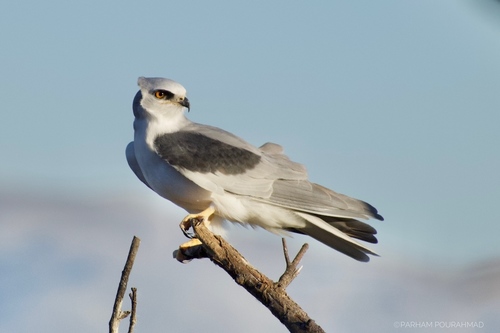
White-tailed Kite
The White-tailed Kite (*Elanus leucurus*) is a striking raptor known for its elegant hovering flight and distinctive plumage. Found across parts of North and South America, this bird plays a crucial role in controlling rodent populations within its grassland and open woodland habitats. Unlike many raptors that have suffered population declines, the White-tailed Kite has adapted relatively well to some human-altered landscapes, even expanding its range in certain areas. It holds no particular widespread cultural significance, though its graceful flight and beneficial role in agriculture are generally appreciated.
35-43 cm
Length
88-102 cm
Wingspan
Least Concern
Conservation Status
Distribution
The White-tailed Kite is found in parts of North and South America. In North America, its range extends from the western United States (California, Oregon, parts of the Southwest) south through Mexico and Central America. In South America, it is widespread, occurring in regions of Colombia, Venezuela, Brazil, Argentina, and Chile. They are generally non-migratory, although some populations may make short-distance movements in response to food availability.
Lifespan
The lifespan in the wild is not well documented but is estimated to be around 8-10 years. Lifespan in captivity can be longer.
White-tailed Kite's Habitat
Habitat Types
Grasslands, Savannas, Open woodlands, Agricultural fields, Marshes
Climate Zones
Temperate, Subtropical, Tropical
Adaptations
White-tailed Kites have adapted to hunting in open habitats. Their hovering flight allows them to scan the ground for prey, and their relatively long wings and tail provide maneuverability. They are well-suited to areas with low vegetation, which provides an unobstructed view of their prey.
Variations
Two subspecies are generally recognized: *E. l. leucurus* in South America and *E. l. majusculus* in North America. There may be subtle differences in plumage and size between these populations.
Appearance
Breeding Plumage
Plumage is generally consistent year-round.
Seasonal Feather Changes
No significant seasonal variations.
Sex Based Plumage Differences
Minimal sexual dimorphism. Both sexes have primarily white underparts, pale gray upperparts, and black 'shoulders' (patches on the upperwings).
Notable Features
Red eyes, Black 'shoulder' patches, White tail (as the name suggests), Hovering flight behavior
Diet and Feeding
Primary Foods
Small rodents (voles, mice), Small mammals, Insects (occasionally), Small birds (rarely)
Foraging Behavior
The White-tailed Kite is renowned for its hovering flight, during which it faces into the wind, scanning the ground below for prey. Once prey is spotted, it drops down with talons extended. They also perch on trees or posts to hunt.
Specializations
Their hovering ability is a key specialization, allowing them to hunt effectively in open areas. They have relatively long wings and a light body, facilitating this behavior.
Seasonal Diet Variations
Diet may shift slightly depending on prey availability. For example, they might take more insects during periods when rodent populations are lower.
Behavior
Social Structure
White-tailed Kites are generally solitary or found in pairs during the breeding season. Outside of the breeding season, they may form communal roosts, sometimes with dozens of birds.
Communication
High-pitched whistles, Kee-kee-kee calls, Wing-clapping (during courtship displays)
Migration
Most populations are non-migratory, but some may undertake short-distance movements in response to food availability or weather conditions.
Territorial or Group Behaviors
During the breeding season, pairs defend territories around their nests. Outside of breeding, they are more tolerant of other kites and may roost communally.
Conservation
Threats
Habitat loss (due to urbanization and agricultural intensification), Pesticide exposure (secondary poisoning from consuming poisoned rodents), Shooting (historically, but less common now)
Protection Programs
Habitat restoration and preservation efforts, Monitoring of pesticide use, Public education campaigns
Local National Laws
Protected under the Migratory Bird Treaty Act in the United States.
Population Trend
Generally stable or increasing in many areas.
Population Estimates
The global population is estimated to be in the hundreds of thousands, but precise figures are difficult to obtain.
Interesting Facts
They can hover for extended periods.
This allows them to thoroughly scan the ground for prey in open habitats.
They are sometimes called 'White-tailed Hawks'.
Although they are kites, their hawk-like appearance leads to this common misnomer.
They have expanded their range in some areas.
Unlike many raptors, they have adapted well to some human-modified landscapes.
Faqs about White-tailed Kite
What do White-tailed Kites eat?
Primarily small rodents, such as voles and mice.
Where do White-tailed Kites live?
They inhabit grasslands, savannas, open woodlands, and agricultural areas in parts of North and South America.
Are White-tailed Kites endangered?
No, they are classified as 'Least Concern' by the IUCN.
How can I identify a White-tailed Kite?
Look for a medium-sized raptor with white underparts, pale gray upperparts, black shoulder patches, and a characteristic hovering flight.
Copyright @ Nature Style Limited. All Rights Reserved.
 English
English